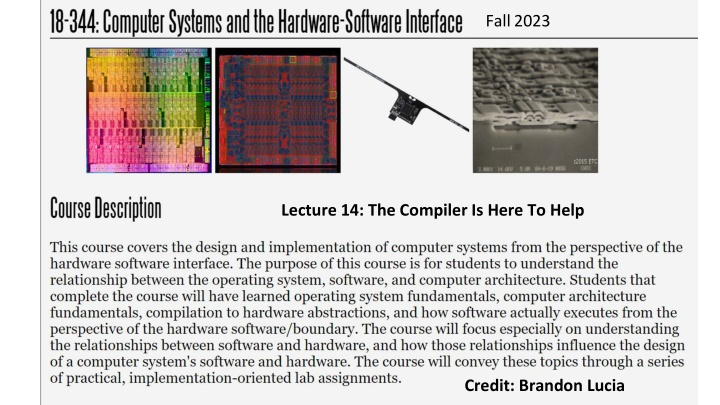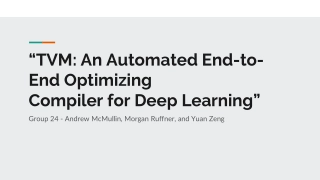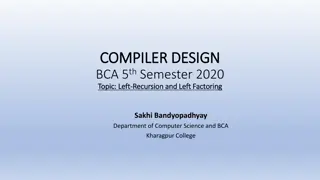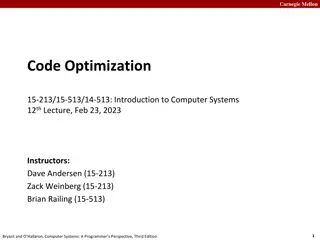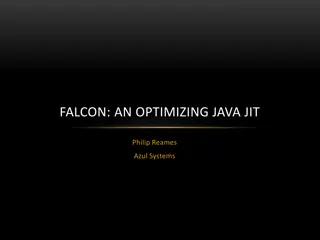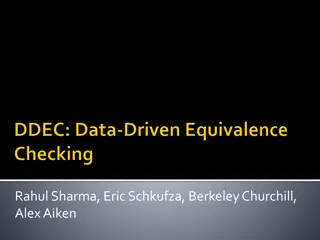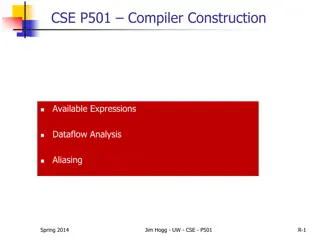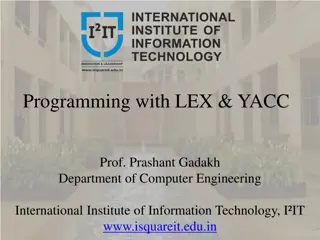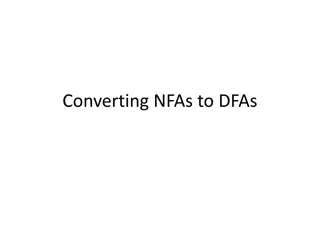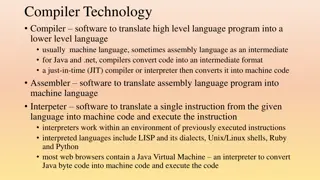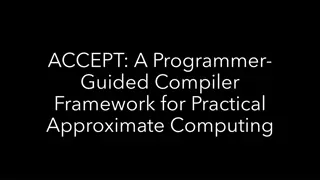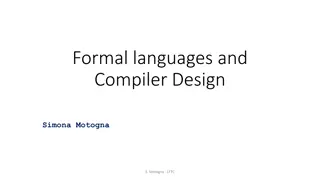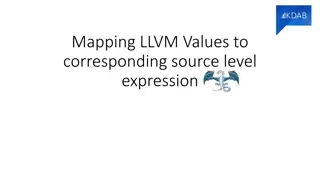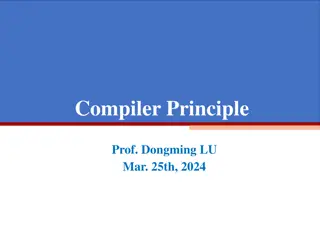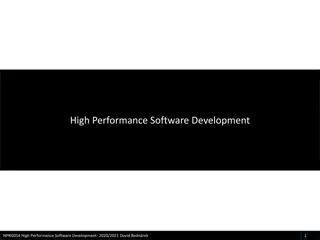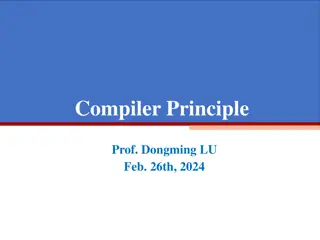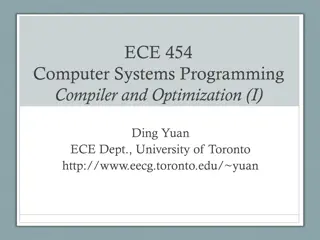Compiler Essentials: Understanding Program Representation
Delve into the foundational aspects of compilers with a focus on program representation, compiler optimizations, and the phases involved in the compilation process. Explore how compilers translate high-level language code into machine code while analyzing, transforming, and checking program structures to ensure efficiency and correctness.
Download Presentation

Please find below an Image/Link to download the presentation.
The content on the website is provided AS IS for your information and personal use only. It may not be sold, licensed, or shared on other websites without obtaining consent from the author.If you encounter any issues during the download, it is possible that the publisher has removed the file from their server.
You are allowed to download the files provided on this website for personal or commercial use, subject to the condition that they are used lawfully. All files are the property of their respective owners.
The content on the website is provided AS IS for your information and personal use only. It may not be sold, licensed, or shared on other websites without obtaining consent from the author.
E N D
Presentation Transcript
Fall2023 Lecture 14: The Compiler Is Here To Help Credit: Brandon Lucia
Today: The Compiler is Here to Help Next we will look to how the compiler represents and reasons about a program We will learn about compiler optimizations and how they get defined and applied Note: This lecture was intended to fall after VLIW and vector machines and before VM in the schedule, but was bumped back by one lecture to give you more time on the VM lab. When studying later, you may want to review it at that point in your flow.
Purpose & Operation of a Compiler Compilers process high-level language code to (eventually) produce machine code Organized into a front-end, middle-end , and back-end. Middle-end analyzes/transforms program represented as an Intermediate Representation
Front-end Phases in the Compiler Input: High-level Language / C Program Generation of Intermediate Representation (IR) Semantic Analysis Parsing Scanning / Lexing Output: IR to process in middle-end
Scanning / Lexing: Reading in raw characters Process input string from code file into characters Use finite state machine to process characters into lexemes to match tokens Maximal Munch Rule: Always match longest available lexeme to token Output: series of tokens identified by a (string) name that can be parsed to give semantic meaning while (save[i] == k): i += 1; w h i l e ( s a v e [ I ] = = k ) : i + = 1 ; A scanner or lexer processes text into tokens while ( save [ ] i == k ) i += 1 ;
Parsing tokens Assemble tokens into an abstract syntax tree (AST) that represents the syntactic structure of the program Tree represents recursive substructure of program Includes sufficient information to assign semantics to components of the tree for analysis, optimization, and mapping to machine instructions
Semantic Checking & Analysis Programmatically examine the AST to find a broad class of common errors Creates a symbol table mapping names & types in program Type checking (most): make sure computations only applied to correct kinds of values Ownership/Borrow Checking (some): make sure only zero or one writable reference to a memory location Data-race checking (some): make sure that no code allows data races Security / data integrity checking: make sure that non-trustworthy operations to do not see secret data Type: (integer, integer) Type: integer Type: integer
Converting to Intermediate Representation (IR) Purpose of IR: simple set of semi-universal, language- and machine-independent operations to which to apply analysis & optimizations Structure of IR: varies depending on the IR model used by compiler, usually looks assembly-ish & has hierarchical structure (functions, blocks, instructions)
IR: Linear View vs. Control-flow Graph View Linear: Directly maps to high-level code, no recursive/hierarchical sub-structure Control-flow Graph: Break code into basic blocks (linear, single entry point, single exit point) with arcs describing possible control flows
Single Static Assignment (SSA) All registers in IR are fresh virtual registers, assigned to exactly once anywhere in the code. These registers do not correspond to any machine. Why?
SSA Makes Dependence Chains Easy Definition Use Chains (or Def-Use Chains) emerge directly from analysis of virtual register assignments and uses
nodes: Handling Control-flow Divergence When control paths diverge, need to re-converge eventually If single variable conditionally assigned on both sides of branch, how to decide its value? x = 0; if(cond){x+=1} else{x+=2}; y = x + 1; r100 = 0 If cond r101 = r100+1 r102 = r100+2 without , what value would we assign to r103? r103 = (r101,r102) r104 = r103+1
Compiler Optimizations Local Optimization: optimize operations within a single basic block; cleanup before global optimizations Global Optimization: optimization across basic blocks Global register allocation: Register mapping pass required for making code fast
Optimization Example: Dead Code Elimination x = 0; if(x>0){x+=1} else{x+=2}; y = x + 1; Why would you have a program with weird code like this in it? x = 0; x += 2; y = x+1;
Optimization Example: Constant / Copy Propagation x=0 x+=2 y = x+1 x = 0; if(x>0){x+=1} Significantly simplified from our original code by applying a sequence of optimizations else{x+=2}; y = x + 1; y = 3;
Optimization Example: Common Subexpression Elimination x[i] = x[i] + 4 // x[i] + 4 la r100,x ld r101,i slli r102,r101,3 add r103,r100,r102 ld r104, 0(r103) // x[i] is in r104 addi r105, r104,4 sd r105, 0(r103) // x[i] + 4 la r100,x ld r101,i mul r102,r101,8 add r103,r100,r102 ld r104, 0(r103) // addi r105, r104,4 la r106,x ld r107,I mul r108,r107,8 add r109,r106,r107 sd r105,0(r109)
Optimization Example: Strength Reduction x[i] = x[i] + 4 // x[i] + 4 la r100,x ld r101,i slli r102,r101,3 add r103,r100,r102 ld r104, 0(r103) // x[i] is in r104 addi r105, r104,4 sd r105, 0(r103) // x[i] + 4 la r100,x ld r101,i mul r102,r101,8 add r103,r100,r102 ld r104, 0(r103) // addi r105, r104,4 la r106,x ld r107,I mul r108,r107,8 add r109,r106,r107 sd r105,0(r109)
Global Optimization Example: Code Motion / Induction Variable Elimination while (save[i] == k): i += 1; Induction Variable Elimination: Re-write induction variable update & address computation directly Code Motion: hoisted outside of the loop add 1 to I add 1 to I add 8 to addr addr = save + i*8 via ld slli addi ld k every time around the loop Global optimizations tend to be more complex and involve reasoning that is more difficult to prove correct
Register Allocation: Eliminating Memory Loads and Stores Register Allocation: Map to assembly/ machine registers Load/Store Elimination: Remove loads from/stores to memory for vars in regs Load/Store temp variables before/after use
Register Allocation: Algorithmically Region-based Register Allocation Finding Regions: 1. Choose a variable definition, d (assignment); add its basic block to region, R 2. Find uses, u_i of the definition d in other basic blocks, add those basic blocks to R; add any block on a path between a definition s block and the use s block to R too. 3. Find any other definitions that could affect u_i and add the blocks containing those definitions to R 4. Repeat steps 2 and 3 until you do not add any more regions to R. Property of resulting set of blocks: if the variable subject to definition d is allocated in register in these blocks, then there is no need to load and store the variable after its initial load/definition Proof Intuition: definitions flow through these and only these blocks along reachable paths to all possible uses. If all uses and defs use the same register name, no need to write to/read from memory).
Register Allocation: Algorithmically Region-based Register Allocation Mapping to machine registers: 1. Compute regions for each virtual/IR register in program 2. Construct region interference graph, G=(V,E): V = {regions}, E = { (r1,r2) | r1 and r2 include a basic block in common} 3. Run graphColor(G) to assign a color to each region such that no adjacent vertices in G have the same color 4. If #colors <= #machine registers, assign one machine register per color and register allocate variables in regions. 5. If #colors > #machine registers, need to spill register to memory with load/store pair, essentially splitting regions until #colors <= #machine registers Key property: regions that do not include overlapping basic blocks can use the same register for a different value/definition
Is the code you write the code you run? while(save[i] == k]): x[i] = x[i] + 4 Key idea: optimize the inner loop automatically! Inner loop in initial IR representation is 12 instructions long including 7 mem ops (long time if not cache hits). Inner loop in optimized version is 5 instructions including 1 mem op.
Intermediate Representation Design What properties are desirable in an IR? (what properties are undesirable in an IR?) How to select an IR if you are a compiler writer? What aspects of the IR do you care about if you re a programmer? What aspects of the IR do you care about if you re an architect?
Enter: LLVM the new great IR ca. 2004 Designed to support transparent program analysis and transformation for arbitrary programs Provide high-level information to compiler at compile-time, link-time (and run-time); always have a CFG Language-independent type system Explicit support for typed address arithmetic Uniform abstraction for exception-handling (setjmp / longjmp) Code representation based on Single Static Assignment (SSA) with explicit phi nodes
Enter: LLVM the new great IR ca. 2004 LLVM has remained the industry and research standard IR for making custom compilers for nearly two decades GCC, which you re very familiar with also, is less extensible, but more robust and with a longer lifetime of community support Recently, new players with applications changing dramatically what an awful logo!
Do we need a better IR?MLIR the Multi-Level Intermediate Representation The MLIR project is a novel approach to building reusable and extensible compiler infrastructure. MLIR aims to address software fragmentation, improve compilation for heterogeneous hardware, significantly reduce the cost of building domain specific compilers, and aid in connecting existing compilers together. Features: Ability to represent dataflows directly (including TensorFlow for ML) Optimization over dataflow graphs directly high-performance-computing-style optimizations across compute kernels Hardware dependent features: DMA insertion, cache management, memory tiling mapping to vector hardware primitives Hardware accelerator specific operations Interesting to see where this project goes in the next year or two
Do we need an IR specifically made for machine learning computations? Relay IR for Machine Learning / Tensor processing frameworks Map from any high-level ML framework to IR Generate orthogonal control (runtime code) and scheduling / hardware mapping (data layout + operators) Highly specialized for ML & Tensor-specific optimization
What else can compilers do for you? Compilers do more than just map to machines and optimize for you Support for debugging and profiling instrumentation Analysis to check security properties
Compiling to profile (like gprof) Insert code that tracks transitions into every basic block (reality: track at path granularity to cut down on tracking code) Runtime: randomly sample using a timer which block active & make histogram More frequent block in histogram == hot code/inner loop
Compiling to help with debugging: Concurrent Data Provenance Tracking Compiler inserts code on every write operation to dynamically track the last writer instruction and thread ID of a variable On crash or breakpoint, last writer table helps understand provenance of value in crash/op Useful for concurrency bug debugging https://github.com/blucia0a/CTraps-gcc
Information Flow Control Analysis for Security Non-privileged operations not allowed to access/be influenced by secret data Secret number should never flow to any operation unless we trust that operation with the secret (i.e., correct guess) Compiler uses taintpropagation analysis to tag data and operations Rule: untrusted op never directly or indirectly affected by confidential data Equivalent rule: High-assurance op never directly or indirectly affected by untrusted data
What did we just learn? A whirlwind tour of compilers and their design and purpose Compilers analyze and translate code you write to be code you run Many types of optimization get applied to your code Register allocation (and other steps that we omitted) map your code down to the machine Compilers are good for a host of other interesting analysis Learning LLVM or another compiler-building framework is like a low-grade super-power. Very worth the effort!
What to think about next? Next up: Sparse problem optimization Further along: Parallelism/concurrency REMINDER: Today s lecture logically falls after the advanced architecture lectures, including VLIW and Vector Machines, which we covered before break. We intentionally misplaced it to let us cover VM and start the VM project earlier, just to give you a little more time on the project.
